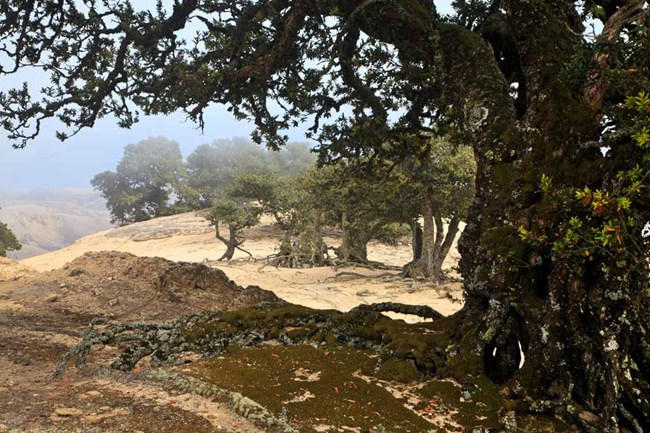
Learn more about the cloud forest at Building a Cloud Forest From the Ground Up However, beginning in the mid-1800s, grazing by non-native animals like sheep, feral pigs, cattle, horses, deer, and elk eliminated most of this cloud forest, along with over 75% of the entire island's native vegetation. When Santa Rosa Island became a part of Channel Islands National Park efforts began to encourage the recovery of native vegetation, beginning with the removal of all non-native grazing animals. The recovery that has followed these actions has been remarkable. Many native plants are now spreading beyond the canyon walls and cliffs where they remained protected from grazing for over 150 years, reestablishing themselves throughout the island. Unfortunately, Santa Rosa Island's cloud forests are not recovering. The areas where they were once found have become too harsh for the chaparral plants that protected and nourished the oak and pine trees to reestablish themselves. Grazing animals stripped the soil down to bedrock, creating deep, barren gulleys that are prone to extreme wind and water erosion. Without the chaparral shrubs, stands of ancient island oaks, which grow nowhere else in the world except on the California Channel Islands, are having the soil and bedrock worn away around them by winds of up to 50 mph. Once their roots are exposed, sometimes to depths of 5 feet, these trees topple, leaving behind more barren ground where acorns and other seeds find no moist nursery in which to grow. Now that the grazing animals have been removed from the island, we have an opportunity to help this amazing environment fully recover. To restore the chaparral and, ultimately, the cloud forest, the US Geological Survey is working closely with Channel Islands National Park and other collaborators to do what the absent chaparral cannot, in order to start the recovery cycle: slow wind and water erosion, trap leaf litter on the ground, collect native seeds, and harvest fog with artificial structures to water plants grown in the island nursery. The details of these restoration efforts include:
Visit our keyboard shortcuts docs for details
Learn about the cloud forest on Santa Rosa Island.
Visit our keyboard shortcuts docs for details
The September From Shore to Sea lecture featured Dr. Kathyrn McEachern’s research on how environmental changes have affected the way coastal fog sustains vegetation on the Channel Islands.
Visit our keyboard shortcuts docs for details
Learn about the cloud forest of Santa Rosa Island. |
Last updated: October 7, 2021
